Literature/1963/Lorenz
< Literature < 1963| Authors | ||
|---|---|---|
|
A B C D E F G H I J K L M N
|
| |
Author
- Harvard (Master's 1940)
- MIT (SM 1943, ScD 1948)
- Professor Emeritus (1987-2008) at MIT
- Publications
- The term [butterfly effect] was first recorded from Lorenz's address at the annual meeting of the American Association for the Advancement of Science, on December 29, 1979. [c 1]
- According to the Web of Science online academic database, this paper has received at least 4000 unique citations by subsequent authors, making it one of the most-cited papers of all time.
Wikimedia
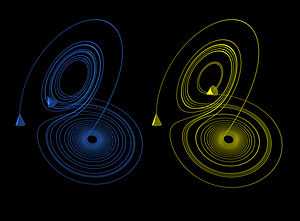
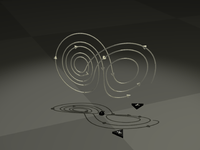
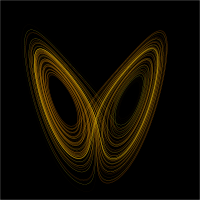
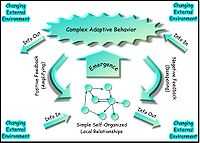
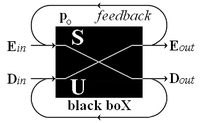
- The Lorenz attractor, named for Edward N. Lorenz, is an example of a non-linear dynamic system corresponding to the long-term behavior of the Lorenz oscillator. The Lorenz oscillator is a 3-dimensional dynamical system that exhibits chaotic flow, noted for its lemniscate shape. [c 2] The map shows how the state of a dynamical system (the three variables of a three-dimensional system) evolves over time in a complex, non-repeating pattern.
- In chaos theory, the butterfly effect is the sensitive dependence on initial conditions; where a small change at one place in a nonlinear system can result in large differences to a later state. [c 3] For example, the presence or absence of a butterfly flapping its wings could lead to creation or absence of a hurricane. [c 4]
- Although the butterfly effect may appear to be an esoteric and unusual behavior, it is exhibited by very simple systems: for example, a ball placed at the crest of a hill might roll into any of several valleys depending on slight differences in initial position. [c 5]
- In 1961, Lorenz was using a numerical computer model to rerun a weather prediction, when, as a shortcut on a number in the sequence, he entered the decimal .506 instead of entering the full .506127. The result was a completely different weather scenario. Lorenz published his findings in a 1963 paper for the New York Academy of Sciences noting[citation needed] that "One meteorologist remarked that if the theory were correct, one flap of a seagull's wings could change the course of weather forever." Later speeches and papers by Lorenz used the more poetic butterfly. According to Lorenz, when Lorenz failed to provide a title for a talk he was to present at the 139th meeting of the American Association for the Advancement of Science in 1972, [c 6] Philip Merilees concocted Does the flap of a butterfly’s wings in Brazil set off a tornado in Texas? as a title. Although a butterfly flapping its wings has remained constant in the expression of this concept, the location of the butterfly, the consequences, and the location of the consequences have varied widely. [c 7]
- Sensitivity to initial conditions is popularly known as the "butterfly effect", so called because of the title of a paper given by Edward Lorenz in 1972 to the American Association for the Advancement of Science in Washington, D.C. entitled Predictability: Does the Flap of a Butterfly’s Wings in Brazil set off a Tornado in Texas? The flapping wing represents a small change in the initial condition of the system, which causes a chain of events leading to large-scale phenomena. Had the butterfly not flapped its wings, the trajectory of the system might not have been vastly different. [c 8]
- The Lorenz attractor is perhaps one of the best-known chaotic system diagrams, probably because it was not only one of the first, but it is also one of the most complex and as such gives rise to a very interesting pattern which looks like the wings of a butterfly. [c 9]
- A pioneer in the field, and inspired by Karl Popper's [c 10] and Warren Weaver's [c 11] works, Nobel prize economist and philosopher Friedrich Hayek dedicated much of his work, from early to the late 20th century, to the study of complex phenomena, not constraining his work to human economies but venturing into other fields such as psychology, biology and cybernetics. Gregory Bateson played a key role in establishing the connection between anthropology and systems theory; he recognized that the interactive parts of cultures function much like ecosystems.
- Further Steven Strogatz from Sync stated that "every decade or so, a grandiose theory comes along, bearing similar aspirations and often brandishing an ominous-sounding C-name. In the 1960s it was cybernetics. In the 1970s it was catastrophe theory. Then came chaos theory in the '80s and complexity theory in the '90s." Later, complex science researches try to combine the natural science and the social science namely consilience science in the '00s.
- One of Hayek's main contributions to early complexity theory is his distinction between the human capacity to predict the behaviour of simple systems and its capacity to predict the behaviour of complex systems through modeling.
- Complexity theory is rooted in Chaos theory [...] Chaos is sometimes viewed as extremely complicated information, rather than as an absence of order. The point is that chaos remains deterministic. With perfect knowledge of the initial conditions and of the context of an action, the course of this action can be predicted in chaos theory. As argued by Ilya Prigogine, complexity is non-deterministic, and gives no way whatsoever to precisely predict the future ....
- When one analyzes complex systems, sensitivity to initial conditions, for example, is not an issue as important as within the chaos theory in which it prevails. [...] the study of complexity is the opposite of the study of chaos. Complexity is about how a huge number of extremely complicated and dynamic sets of relationships can generate some simple behavioral patterns, whereas chaotic behavior [...] is the result of a relatively small number of non-linear interactions.
- Therefore, the main difference between Chaotic systems and complex systems is their history. Chaotic systems do not rely on their history as complex ones do.
- In a sense chaotic systems can be regarded as a subset of complex systems distinguished precisely by this absence of historical dependence. Many real complex systems are, in practice and over long but finite time periods, robust. However, they do possess the potential for radical qualitative change of kind whilst retaining systemic integrity. Metamorphosis serves as perhaps more than a metaphor for such transformations.
Chronology
- Strogatz, Steven H. (1994). Nonlinear Systems and Chaos. Perseus publishing.
- Frøyland, J. & K. H. Alfsen (1984). "Lyapunov-exponent Spectra for the Lorenz Model". Phys. Rev. A 29 (5): 2928-2931.
- Grassberger, P. & I. Procaccia (1983). "Measuring the Strangeness of Strange Attractors". Physica D 9 (1-2): 189-208.
- Knobloch, Edgar (1981). "Chaos in the Segmented Disc Dynamo". Physics Letters A 82 (9): 439-440.
- Lorenz, Edward Norton (1976). "Nondeterministic Theories of Climate Change." Quaternary Research. Vol.6
- Haken, H. (1975). "Analogy between Higher Instabilities in Fluids and Lasers." Physics Letters A 53 (1): 77-78.
- Lorenz, Edward Norton (1972). "Predictability: Does the Flap of a Butterfly's Wings in Brazil Set Off a Tornado in Texas?" Address at the 139th Annual Meeting of the American Association for the Advancement of Science, Sheraton Park Hotel, Boston, Mass., December 29, 1972. [+]
- Edward N. Lorenz (1969). "Atmospheric Predictability as Revealed by Naturally Occurring Analogues." Journal of the Atmospheric Sciences 26: 636-646.
- Lorenz, Edward Norton (1963). "Deterministic Nonperiodic Flow". Journal of Atmospheric Sciences 20(2): 130-141. [+]
Comments
The second law of thermodynamics is such that nature gets more and more complex to the maximal entropy or to death over time, hence an indicator or arrow of time in a way. The butterfly effect sounds against it as well as contextualism. To overrate the initial condition is to underrate the general context, process, hystery, history, karma, and the like, hence speaking well of rationalism and innatism and ill of empiricism and behaviorism.
Accordingly, the universe just looks like a huge mathematical, computational automaton after the big bang. Science is just to be surprised at the bigger and bigger gap between the initial and subsequent states. There seems to be a nice chance of deductivist and reductionist predictions, regardless of "theory-laden" experiments. Everything good must rise from God while everything evil from Satan.
It should be taken seriously instead that the whole universe may exactly react or respond to every differential action or stimulation, including not only the initial but also all the subsequent conditions. Then the butterfly effect may be an oversimplification, typical of radical reductionism. The suggestive or supporting mathematical, computational simulation may have little or no bearing on actual phenomena at all.
Such may be the general pitfall of computationalism and cognitivism.
- ↑ His publications at http://eapsweb.mit.edu/research/Lorenz/publications.htm does not include the documentation of December 29, 1979 but December 29, 1972, as related to the the meeting at the American Association for the Advancement of Science where the "butterfly effect" was perhaps first nearly (not exactly) suggested rather than "first recorded" in 1979. As such, the exact origin of the very term is yet unclear.
- ↑ In a way, The lemniscate shape looks like a butterfly.
- ↑ The sensitive dependence on initial conditions appears to fight for rationalism and nativism, and against empiricism and behaviorism. It tends to ignore the Markoff process, Bayesian inference and historicism in general.
- ↑ Is this a legitimate hypothesis or sophistry? It sounds like opposing to the second law of thermodynamics and the arrow of time.
- ↑ This narrative mostly takes the initial and final states into account, regardless of all the complex incremental process in between. This point of view may well be called rationalist or deductivist reductionism.
- ↑ The year 1972 may be true, while "the term was first recorded from Lorenz's address ... on December 29, 1979" as noted above.
- ↑ The term "butterfly effect" may best be explained by Edward Lorenz. Disappointing in this regard, however, is the latest (2008). So it seems to remain unclear when and how the term came into being, exactly.
- ↑ The vast difference may not so much rise from the initial condition as from the subsequent ones of all complexity. The rivers rising from one or more, the same or the different, watersheds may eventually merge altogether into a confluence. The initial condition is just part of the whole making up the stochastic process. The total sensitivity should be accumulated or integrated over time. The butterfly effect or chaos theory may be a radically reductionistic oversimplification.
- ↑ The term "butterfly effect" may simply stem from such a pattern as looking like a butterfly's wings rather than from "the flap of a butterfly's wings in Brazil" (Lorenz 1972) where he suspected it to cause to "set off a tornado in Texas."
- ↑ Complex systems take historicity or historicism seriously. Then it sounds quite absurd that Hayek, a remarkable pioneer of the theory was "inspired by Karl Popper," the author of The Poverty of Historicism (1936), not to mention Warren Weaver.
- ↑ Warren Weaver is too famous for information theory to contribute to complexity theory. The former as well as chaos theory has to do without historicity whereas the latter has to do with it.
